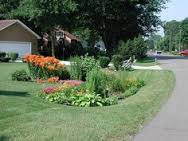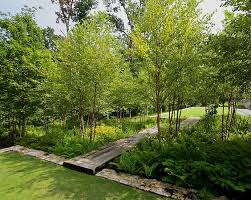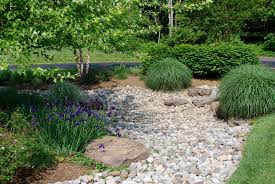Storm water poses a serious challenge to many communities. Unchecked, it will run off from your roof or the driveway and onto the streets. From there it moves into the drainage system and finally into the waterways. Rain Gardens can help.

In principal there is nothing wrong with how municipal storm water systems are intended to work. However, as the water flows over the various surfaces, it picks up a lot of litter and chemicals. These also end up in the lakes, rivers and streams where they can cause serious harm to biodiversity. Another big problem with Storm water, is that it is extremely powerful.
On a sloping property water gathers speed as it moves. This leads to erosion as top soil is washed away, again ending in drains and waterways.
In rural areas, where communities do not have access to seemingly limitless water from large reservoirs, disappearing storm water is a lost resource.
A cleverly built rain garden can help with all of these issues.
What are rain gardens?
The term “rain garden” simply refers to a depression or bed that is positioned to trap the storm water. This depression prevents run off, trapping the moving water, and allowing it to be gradually absorbed into the ground. The great advantage of rain gardens is that they can be designed to seamlessly blend into your landscape.

Depending on design. they can also beautify an area, while trapping, and purifying water, before it gradually seeps back into the landscape.
This also means healthier lawns, gardens and orchards, all with a lower dependence on community water supplies.
The Rain garden starts by creating an absorbent depression in a location where it will collect running water. Adding good compost attracts worms and increases water absorption.
In some cases, it will help to add berms on the lower side of the bowl to increase retention.
A wide variety of soils will work in a “rain Garden”, from sandy soils to clay soils.
Plant selection will depend, in part, on the soil type. Mostly, plants need to be able to adapt to being water logged, but still endure dry periods between rain events.
Rain Gardens also vary in size based on the practical uses you are designing them for. On Acreage properties, where catchment and run off areas are large, a larger rain water garden makes sense.

How do the rain gardens work?
While rain gardens help to prevent runoff and erosion, the biggest advantage may be their ability to purify. This is extremely important if the water that eventually leaves your rain garden, enters your creek or stream.
The rain garden helps remove pollutants from the storm water. It does this via a series of processes, making use of various soil properties, plants and microbes inside the rain gardens. The four main purification actions come from:-
- Settling of the water
- The chemical processes
- The uptake by plants
- Bio-degradation occurring in the root zones
Settling: The rain garden consists of a physical depression that slows down the water flow. As a result, the debris and the soil will settle in the depression instead of flowing into the waterways.The vegetation in the depression also filters off some of the debris in the storm water.
Chemical processes in the soil: The soil in the rain garden basin also reacts with storm water in various ways leading to greater filtration.
Plant uptake: The roots of the plants in the depression will absorb nutrients and subsequently use these in their growth. You can make careful planting choices for your rain gardens, using plants that have a high nutrient intake, leading to a more efficient filtration process.
Bio-degradation in the root zones: The microbes present in the basin can also help in breaking down the harmful chemicals, and removing carcinogens, resulting in cleaner and healthier water flowing into your garden or the waterways.

